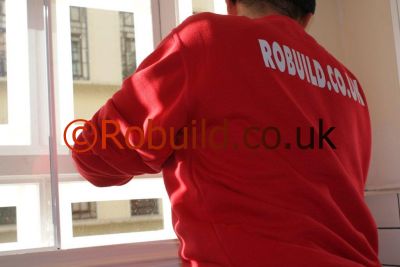General preparation

For general woodwork wash down the surface with sugar soap, washing soda or a proprietary paint cleaner, rinse off with plenty of clean water and allow to dry thoroughly. Fill in any cracks or holes in the wood with a proprietary wood filler. Make a key for the new paint by lightly rubbing down the old gloss to remove the shine with medium fine wet and dry glasspaper wrapped round a wood or cork block. Lightly wet the glasspaper to reduce the spread of dust and rub with the grain. With painted walls wash down as for woodwork to remove all grease and dirt. If gloss paint has been used previously, key the surface with wet and dry glasspaper wrapped round a wood or cork block. Fill any cracks in the plaster with proprietary plaster filler, glasspapering smooth when dry. Make good any damaged plaster.
Painting techniques

When you apply free-flowing oil-based paints with a brush, spread and lay off the paint in the following way to avoid runs and sags. Spread a liberal coat using strong pressure on the bristles, finishing with long parallel strokes along the grain. Wiping any surplus paint on the sides of the can or paint kettle, apply lighter strokes across the surface to provide an even spread. Finally lay off with lighter strokes from the tips of the bristles along the original direction. With emulsion paints, which are water-based and usually heavy bodied, or the gel type non-drip gloss paints, use the minimum of brushing out. Apply with even, random strokes to ensure a full application without paint running. Keep the brushing of non-drip gloss to a minimum, as too much brushing or over-stirring will only make the paint too thin. A second coat of gloss can be applied within 12-24 hours. Alternatively leave the paint at least four days to harden, then lightly rub down the surface with fine glasspaper and dust off before applying a second coat. Always wipe the surface of the paint with a rag when dusting off before the second coat.
Painting walls

Paint a complete wall without a break to avoid edges showing through. If you have to stop, make sure you break off when you reach a corner, such as on a chimney-breast. Use a 100 or 130mm brush, paint pad or roller, working away from the natural light to see where you have painted. With emulsion paint work in 300mm deep horizontal strips across the wall in downward strokes, starting at the top. With oil-based paint work in 600mm squares. If the paint is drying too quickly and the edges cannot be joined up in time to avoid unsightly marks, lower the temperature by turning off any heating to slow down drying. Reverse the procedure when work is complete to accelerate drying.
